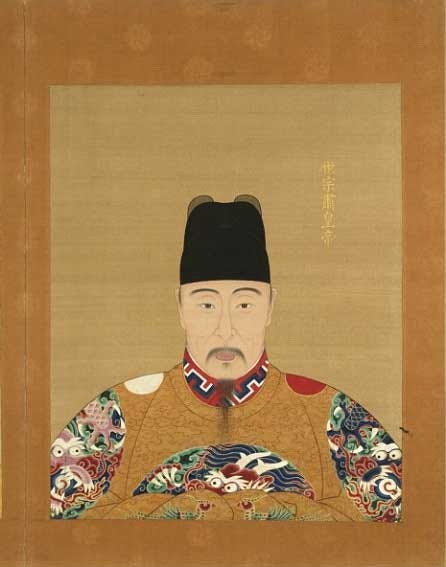When Concubines Fought Back: The Plot to Eliminate a Mad and Sadistic Emperor
The Renyin Plot was an assassination attempt carried out on the sadistically violent Jiajing Emperor, who was the ruler of China’s Ming Dynasty during the 16th century. The assassins almost succeeded in their mission, though the emperor was saved at the last minute…
An Emperor’s Ambition
Throughout Chinese history, the assassination / attempted assassination of emperors is not something entirely unheard of, though that of the Jiajing Emperor may be one of the most unusual. In 1521, Zhu Houcong succeeded his cousin, the Zhegde Emperor, as the 12th Emperor of the Ming Dynasty. Zhu Houcong adopted the regal name Jiajing, which meant ‘admirable tranquility’, but he was far from tranquil.
At the beginning of his reign, the Jiajing Emperor is said to have seemed like a serious and ambitious ruler. His strong will may be seen, for instance, in his conflict with his court in his attempt to bestow on his parents (who had not been on the Chinese throne) the ritual and titles that were appropriate for an imperial lineage.

Whilst this act demonstrated the emperor’s strong will, as well as his upholding of the virtue of filial piety, it also exposed a darker side. The court eventually gave in to the emperor’s demands towards the end of 1521, though a fire in February of the following year allowed them to force Jiajing to suspend his family’s imperial status. The emperor, however, finally succeeded in reinstating his family’s imperial status in 1524, causing hundreds of court officials to protest against the emperor’s decision. Jiajing had some of the protesters thrown into prison, where many are said to have been beaten to death. Others were dismissed from their post.
Whilst Jiajing’s cruel treatment of the officials who opposed him may be considered relatively mild when considering the deeds of certain other Chinese emperors, it was only the beginning, and Jiajing is remembered to have been a brutal emperor.
Jiajing also dabbled in Taoism, or more specifically, in alchemy, as he desired to obtain the legendary elixir of immortality. It was Jiajing’s cruelty, and some say, his quest for the elixir of eternal life, that sparked the Renyin Plot.

The Renyin Plot
The Renyin Plot took place in 1542, and involved 16 palace women who tried to take the life of Jiajing. The name of this plot is derived from the renyin year, which is the 39th year in the sexagenary cycle used in China and other East Asian civilizations. According to some sources, the emperor’s search for immortality involved collecting the menstrual blood of female virgins and using it to make a substance called ‘red lead’, which he consumed. Numerous girls aged 13-14 were kept for the production of this vile concoction, and were fed only mulberry leaves and rainwater, as the Emperor believed this would keep his substance pure. The young women were beaten and starved and if they became ill they were tossed away. His concubines were also violently beaten into submission so they would passively cater to his every sexual whim. It is no wonder the women banded together to plot the murder of this sadistic ruler.

The 16 palace women took action on a night that the emperor spent in the chambers of his favouite concubine, the Consort Duan (known also as Lady Cao). After the concubine withdrew with her attendants, the emperor was left alone, and the palace women took the opportunity to attack. The women held down the emperor while one concubine tried to strangle him with a ribbon from her hair. When this failed, they tied a silk curtain cord around his neck but unfortunately tied the wrong kind of knot and were not able to tighten the noose to finish the job.

Deadly After-effects
One of the conspirators panicked and reported the assassination attempt to Empress Fang. As the emperor was unconscious till the next afternoon, the Empress took matters into her own hand, and had the palace women executed by ‘slow-slicing’, known also as ‘death by a thousand cuts’. The families of these women were also executed. Consort Duan was executed as well. Though it later turned out that the concubine was not involved in the plot, the fact that the assassination attempt took place in her chambers gave the Empress sufficient reason to eliminate a potential rival in the palace.

Following the attempt on Jiajing’s life, the emperor withdrew to the western part of the Forbidden City, where he could live in isolation, and stopped holding court for the next two decades of his reign. Whilst Jiajing’s long reign provided the Ming Dynasty with some stability, his decadence and disregard for the affairs of state led to the deterioration of the country. The Jiajing Emperor died in 1567 at the age of 59. It has been widely speculated that he succumbed to the toxic mercury contained in the ‘elixirs of immortality’ that he had been ingesting over his lifetime.
Top image: A woman in traditional Chinese dress. Source: CC0
By Wu Mingren
References
Hultengren, I., 2017. Zhu Houcong - the Jiajing Emperor. [Online]
Available at: http://www.mingtombs.eu/emp/11jiajing/jiajing.html
Lin, Y., 2014. Fang, Empress of the Jiajing Emperor, Shizong, of Ming. In: L. X. H. Lee & S. Wiles, eds. Biographical Dictionary of Chinese Women, Volume II: Tang Through Ming 618 - 1644. Hong Kong: University of Hong Kong Libraries Publications, pp. 59-61.
McMahon, K., 2016. Celestial Women: Imperial Wives and Concubines in China from Song to Qing. London: Rowman & Littlefield.
The Editors of Encyclopædia Britannica, 2008. Jiajing. [Online]
Available at: https://www.britannica.com/biography/Jiajing
Theobald, U., 2014. Persons in Chinese History - Ming Shizong 明世宗, the Jiajing Emperor 嘉靖. [Online]
Available at: http://www.chinaknowledge.de/History/Ming/personsmingshizong.html
www.walfc.org, 2018. Emperor Jiajing. [Online]
Available at: http://www.walfc.org/project/emperor-jiajing-r-1522-1566/



The story of the Renyin Plot is horrifying and haunting—not because the women failed, but because of what drove them to act in the first place.
History remembers Jiajing as sadistic: starving young girls for “alchemy,” beating concubines into submission, and consuming lives as though they were ingredients in his search for immortality. But what strikes me most is that his cruelty depended on silence. It depended on the assumption that these women could be erased, their suffering buried beneath the façade of imperial power.
Their attempted assassination was not just rebellion; it was testimony. A refusal to remain invisible. A declaration that the body has limits and will not endlessly absorb violence. Even when the plot failed, even when the punishment was brutal beyond comprehension, their act shattered the illusion of unquestioned authority.
In Chronically Under and Over Touched™, I write about how systems thrive on our muted grief and enforced numbness. The Ming court’s violence against women was not just personal cruelty—it was structural, designed to regulate intimacy, reproduction, and memory. And yet, even in that structure, resistance arose.
The Renyin women remind us that survival sometimes looks like transgression, like risking everything for a chance at freedom. Their act echoes across centuries: against emperors, against tyrants, against the machines of modernity that still try to extract our lives while calling it progress.
History’s record is often written by the survivors of power, not the survivors of violence. But in this case, the women’s defiance is what lingers. They remind us that silence is never the only option.